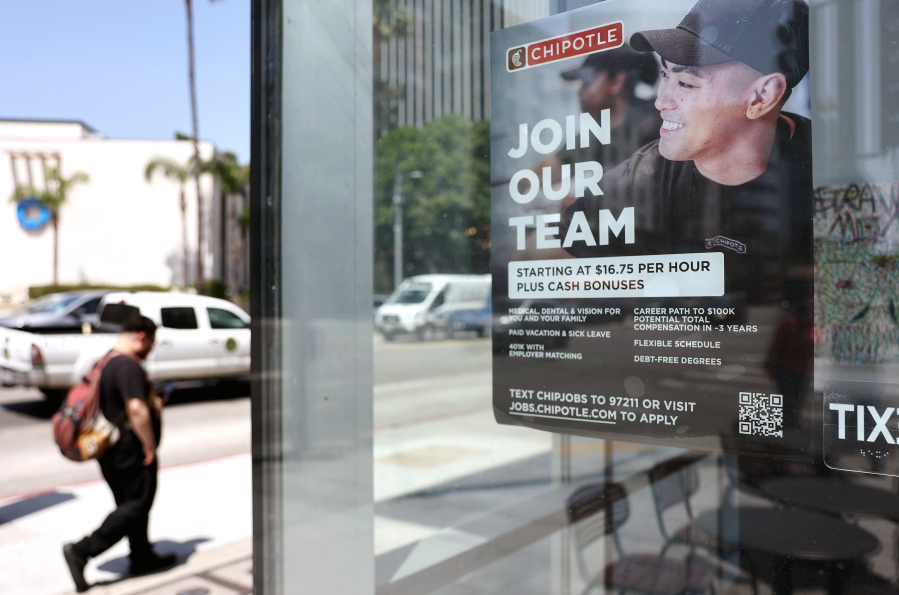The balance of power in the jobs market is slowly tilting back toward employers as companies become choosier with their hires and workers turn more cautious about quitting.
A labor leverage ratio developed by ex-senior White House economist Aaron Sojourner that compares the level of quits to layoffs has retraced about two-thirds of the rise seen in 2021 and into 2022. The ratio surged when companies ramped up staffing after pandemic-driven lockdowns and workers were enjoying outsized pay offers for their services.
“The playing field is evening out,” said Tom Gimbel, chief executive officer of Chicago-based employment agency LaSalle Network.
The shift in the tug-of-war in the jobs market is not great news for employees: While wage gains on average have begun to outstrip inflation, workers have still not made up the ground they lost when prices surged coming out of the worst of the pandemic.
But the tilt is likely to be welcomed by Federal Reserve Chairman Jerome Powell and his central bank colleagues. They’ve openly fretted about what they see as a too-hot jobs market and the implications that carries for labor costs and inflation.
“There has been some loosening in labor-market conditions,” Powell told reporters on June 14 after the central bank left interest rates unchanged for the first time in 11 meetings. “We need to see that continue.”
Powell’s hopes
In testimony to Congress this week, Powell voiced hopes that a drop in job openings and an increase in the supply of workers could help bring the labor market back into better balance, rather than a significant increase in unemployment.
The labor leverage ratio topped out in April 2022, the month after the Fed began raising interest rates to fight inflation after holding them near zero for two years. Sojourner, who’s a senior researcher at the W.E. Upjohn Institute for Employment Research, said the Fed’s action sent a message to businesses that it was intent on slowing the economy through tighter credit — and that they might not need as many workers going forward as they had expected.
“We have seen a softening in demand,” said Jim McCoy, senior vice president of staffing company ManpowerGroup Inc. “Companies are looking at what’s happening with interest rates, what’s happening to their cost of capital, and factoring that into the way they’re hiring.”
The result: The number of open positions available for job seekers is shrinking, even as the labor supply is growing, with more Americans rejoining the workforce and immigration picking up.
Wage impact
Amy Laiker, who heads the New York office of Tiger Recruitment, has seen the tilt in the labor market first hand.
A year ago, “if a company didn’t respond within 24 hours after someone had an interview with them or they didn’t make a decision within a week on whether they wanted to hire them, that candidate was gone,” she said. “Whereas now, they can go a week, two weeks, three weeks, sometimes even four weeks. And that candidate’s probably still out there in the market.”
The shift in the balance of power is slowly starting to affect wages. Worker compensation grew 4.8% in the first quarter from a year ago, down from a 5.1% pace in the previous quarter, Labor Department data show. That’s still well above the 2.7% gain seen in 2019, before the pandemic.
Some salary measures have shown steeper declines in growth rates, especially wages for employees who change jobs.
“Pay growth is slowing substantially, and wage-driven inflation may be less of a concern for the economy despite robust hiring,” said Nela Richardson, chief economist at payroll management company Automatic Data Processing Inc.
It’s not just in wages where the decline in labor leverage has been felt.
A number of big-name companies like BlackRock Inc., Walt Disney Co. and Chipotle Mexican Grill Inc. are calling employees back to their desks four days a week instead of the two-to-three day attendance that’s become the post-pandemic norm at many corporations.
Workers are noticing. Job seekers’ assessment of the medium-term outlook for the labor market has deteriorated significantly since the middle of last year, according to a quarterly survey by ZipRecruiter.
“There’s some growing anxiety and a higher prioritization being put on job security,” ZipRecruiter chief economist Julia Pollak said.
As a consequence, the so-called Great Resignation seems to be coming to an end: The quits rate — the ratio of people leaving their jobs during a month as a percentage of overall employment — fell to 2.4% in April, just a smidgen above its 2.3% average in 2019.
Still, the labor market remains tight, with some industries struggling to staff up to meet revived demand. More than 80% of hotels reported being short of workers in a survey last month by the American Hotel & Lodging Association.
“When we talk to our clients, many of them are saying it’s still a tough hiring environment,” said ADP’s Richardson. “But it’s easier than before. It’s more in balance.”



